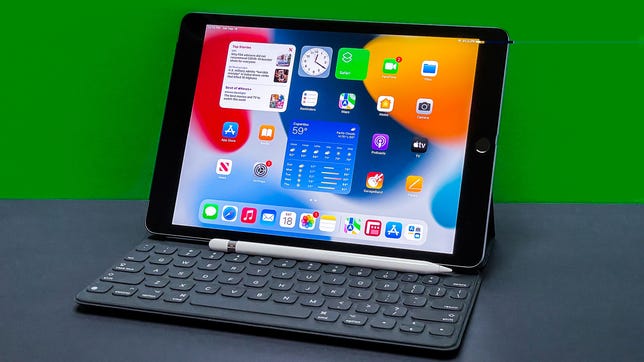Best iPad for 2022 – CNET
[ad_1]
An iPad is the go-to tablet if you are in the market for a big-screen media consumption device that can also get some work done. Maybe you already have an iPhone or a MacBook and want to stay in the Apple family. Or maybe you’re thinking of jumping from an Android tablet to something that gives you access to the iPad’s apps. Regardless of your reasons, if you’re thinking of buying an Apple tablet, there’s a good selection to choose from.
Apple introduced an iPad Air 2022 for the first time since 2020 at its “Peek Performance” event in March, outfitting the new tablet with 5G support, an M1 processor and a Center Stage front-facing camera. We also have our eyes on a new iPad Pro possibly coming this year, but for now, the iPad Pro 2021 is the newly announced Air’s closest rival. We’ll update our recommendations after we’ve gotten a chance to test the new Air, but both its more powerful configuration and the possibility of a new Pro should make you hit “pause” on any potential iPad Pro purchase.
Read more: Best iPad Deals Right Now
Whichever model or screen size you go with, though, all the current iPads support the latest version of iPadOS (a version of iOS specifically for iPads) and either the first- or second-gen Apple Pencil. All but the Mini work with Apple’s Smart Keyboard, though you can use any Bluetooth keyboard instead. That’s good news for anyone who wants to do more than stream videos and music, browse websites and play Apple Arcade games. Plus, all of the current iPad models support mouse and trackpad use for a more MacBook-like experience. The Apple Magic Keyboard is compatible with the iPad Pro and iPad Air. Check out the selections below to find the best iPad for your needs.
More advice follows our specific recommendations.

Apple
The new ninth-gen entry level iPad gains a couple of useful extras over last year’s solid but unexciting model: more storage for $329 (64GB, rather than the ridiculously low 32GB of the last model), a faster A13 chip and better cameras (most importantly, a wider-angle higher-res front-facing Center Stage camera that tracks your face via digital pan and zoom). It still uses the first-gen Apple Pencil, which is fine for the money, and it’s still compatible with a range of keyboard cases. Its predecessors were often on sale for $299 or less and that should be true this holiday season as well.
If you’re planning to do any sort of art on it or download a lot of videos to go, it’s definitely worth opting for the 256GB model. It really needs a 128GB option — it’s annoying that you’re forced to buy more than you need, since 128GB would probably be the sweet spot for price and storage.
The 2020 model has the slower A12 Bionic chip, but it’s also the last remaining full-size iPad with a headphone jack. Going back yet another generation to its seventh incarnation, it’s still a decent pick if you can find the 128GB model for a pittance; you’re best off avoiding the insufficient 32GB model. It can handle the latest iPadOS just fine and should perform all the standard iPad tasks for some years to come.
Read our iPad 2021 review.

Sarah Tew/CNET
The new iPad’s price starts at $100 more than the older iPad model it replaces at $499; that’s certainly not cheap, but you also get a lot more with it than you do with the now dated iPad Air. It’s just a little smaller than that, but it offers optional 5G, USB-C for faster charging and broader connectivity, new digital-zoom Center Stage camera and works with second-gen Pencils, so you can magnetically snap a Pencil right onto the side, which is nice. Plus it incorporates the new A15 Bionic chip for better performance. You might feel a bit cramped for using it for work or professional graphics, but 8.3 inches doesn’t feel quite so tiny anymore. This smallest iPad has a Liquid Retina display with True Tone and wide color, and promises up to 10 hours of battery life. Given that the 2021 model remains the smallest in the line, we continue to recommend it as the best option for commuters.
Read our Apple iPad Mini 2021 review.

Scott Stein/CNET
Whether you’re a digital artist or have waited years for a new iPad Pro that blurs the line between tablet and MacBook, the latest iPad Pro is what you want. The 11- and 12.9-inch Pros are nearly the same, save for their screen sizes and higher resolution and XDR technology in the 12.9-inch version based on Mini LED display backlighting technology. If you’re an intensive user of graphics apps like those in Adobe Creative Cloud, you’ll definitely appreciate the higher performance of the M1-driven Pro.
If you’re considering the 11-inch iPad Pro as a laptop replacement, we recommend you spring for the 12.9-inch version for the significant increase in workspace; if you’re a screen buff, you may also want it for the Liquid Retina XDR display. Also note that there’s a price jump when you get a 1TB or 2TB model, because the RAM doubles from 8GB to 16GB for those who really need as much power as possible.
Along with the increased performance, these were the first iPads to offer support for wireless 5G connectivity, though now Apple has expanded the 5G option to other models in the line. They’re still not quite the MacBook replacement some crave, but they’re getting closer every year.
Read our iPad Pro 2021 review.

Sarah Tew/CNET
The newest iPad Air has the same starting price ($599) and starting storage (64GB) as it did a year and a half ago, but adds an M1 processor similar to the iPad Pro from 2021, a 5G option and a Center Stage front-facing camera. It looks fast, and it’s sure to be a welcome power upgrade from the 2020 model, but it leaves off a bunch of little perks that the iPad Pro has.
Read more: The Best iPad Games You Need to Play
What are the differences among the top iPad models?
The current 11- and 12.9-inch iPad Pro models as well as the 2022 Air are powered by the company’s M1 processor, the chip found in its latest MacBooks as well as the new 24-inch iMac. Along with the new processors, the iPad Pros have a Liquid Retina XDR display, at least on the 12.9-inch size, high-speed Thunderbolt USB-C port and optional 5G mobile wireless. The 11-inch version starts at $799 while the 12.9-inch model price begins at $1,099. The iPad Air starts at $599.
Read more: Which iPad Should You Buy Now?
iPad 2021 vs. iPad Air 2022 vs. iPad Pro 2021 specs
| iPad 2021 10.2-inch (5th gen) | iPad Air 2022 10.9-inch (5th gen) | iPad Pro 2021 11-inch (3rd gen) | iPad Pro 2021 12.9-inch (9th gen) | |
|---|---|---|---|---|
| Display resolution | 2,160×1,620-pixel resolution | 2,360×1,640-pixel resolution | 2,388×1,668-pixel resolution | 2,732×2,048-pixel resolution |
| Pixel density (pixels per inch) | 264 ppi (Retina) | 264 ppi (Liquid Retina True Tone) | 264 ppi (Liquid Retina True Tone with ProMotion) | 264 ppi (Liquid Retina XDR True Tone with ProMotion) |
| Rear camera | 8-megapixel f2.4 | 12-megapixel f1.8 | 12-megapixel f1.8 wide, 10-megapixel f2.4 ultrawide | 12-megapixel f1.8 wide, 10-megapixel f2.4 ultrawide |
| Video recording | 1080p at 30fps | 4K at 24, 30 or 60fps; 1080p slo-mo at 120 or 240fps | 4K at 24, 30 or 60fps (wide); 60fps (ultrawide) | 4K at 24, 30 or 60fps (wide); 60fps (ultrawide) |
| FaceTime front-facing camera | 12-megapixel photos; 1080p video | 12-megapixel f2.4 ultrawide; 1080p video | 12-megapixel TrueDepth; 1080p video | 12-megapixel TrueDepth; 1080p video |
| Processor | A13 | M1 | M1 | M1 |
| Dimensions | 9.8×6.8×0.29 inches | 9.7x7x0.24 inches | 9.7x7x0.23 inches | 11×8.5×0.25 inches |
| Weight | 1.07 lbs. (Wi-Fi); 1.09 lbs. (LTE) | 1.02 lbs. | 1.03 lbs. (Wi-Fi); 1.04 lbs. (LTE) | 1.5 lbs. (Wi-Fi); 1.51 lbs.(LTE) |
| Battery | Up to 10 hours use over Wi-Fi; up to 9 hours over cellular | Up to 10 hours use over Wi-Fi; up to 9 hours over cellular | Up to 10 hours use over Wi-Fi; up to 9 hours over cellular | Up to 10 hours use over Wi-Fi; up to 9 hours over cellular |
| Headphone jack | Yes | No | No | No |
| Connector port | Lightning; Apple Smart Connector | USB-C; Apple Smart Connector | USB-C with Thunderbolt 4/USB 4 support | USB-C with Thunderbolt 4/USB 4 support |
| Apple Pencil-compatibility | Yes; first generation | Yes; second generation | Yes; second generation | Yes; second generation |
| Unlock with | Touch ID | Touch ID | Face ID | Face ID |
| Wi-Fi, Bluetooth | 802.11ac, Bluetooth 4.2 | 802.11ax, Bluetooth 5.0 | 802.11ax, Bluetooth 5.0 | 802.11ax, Bluetooth 5.0 |
| SIM card support for cellular model | Nano-SIM; eSIM | Nano-SIM; eSIM; 5G NR support | Nano-SIM; eSIM; 5G support (sub-6 GHz and mmWave) | Nano-SIM; eSIM; 5G support (sub-6 GHz and mmWave) |
| iPad Keyboard compatibility | Smart Keyboard | Magic Keyboard, Smart Keyboard Folio | Magic Keyboard, Smart Keyboard Folio | Magic Keyboard, Smart Keyboard Folio |
| Audio | Two-speaker | Two-speaker | Four-speaker | Four-speaker |
| Capacity and price: Wi-Fi models | $329 (32GB) / $479 (256GB) | $599 (64GB) / $749 (256GB) | $799 (128GB) / $899 (256GB) / $1,099 (512GB) / $1,499 (1TB) / $1,899 (2TB) | $1,099 (128GB) / $1,199 (256GB) / $1,399 (512GB) / $1,799 (1TB) / $2,199 (2TB) |
| Capacity and price: cellular models | $459 (32GB) / $609(128GB) | $749 (64GB) / $899 (256GB) | $999 (128GB) / $1,099 (256GB) / $1,299 (512GB) / $1,699 (1TB) / $2,099 (2TB) | $1,299 (128GB) / $1,399 (256GB) / $1,599 (512GB) / $1,999 (1TB) / $2,399 (2TB) |
Can I use an iPad instead of a MacBook?
Sort of. Its processor is as powerful as a MacBook Air’s and it works with Bluetooth keyboards and Apple trackpads. But it’s held back from acting as a true replacement by iPadOS; that means, among other things, no useful dual-monitor support (it can only mirror, not extend, to a second display) and no support for full desktop applications. Though you might pooh-pooh the latter — after all, Apple says you can do it all with an iPad — for most school and work requirements you’ll find at least one thing you need to do on a laptop. For instance, even if I could do my job on an iPad Pro (and it’s not even close), in order to access some corporate locations I have to run the VPN, which is only available on company-issued systems.
Many limitations of current mobile apps have carried through into iPadOS. In some cases it may just because developers are still building out apps and haven’t yet gotten them yet to full featuredom, though there’s no guarantee they ever will get there. Adobe Lightroom is a fine “light” Lightroom, but Adobe intended it from the start to be mobile-first, and thus lack some features important to professionals, including wired tethered shooting, optimization for local file storage (rather than cloud) and the ability to intelligently handle raw+JPEG.
Read more: Is the iPad Pro Your Next Laptop?
[ad_2]
Fonte da Notícia: www.cnet.com


